How to sharpen a saw correctly?

A saw is a working tool that, like all others, requires compliance with the rules of operation, maintenance and periodic sharpening. Unfortunately, when purchasing a product in a store, you cannot be sure that it is completely ready for use; you still need to make sure of this during operation.

Sharpening signs
The first sign that a regular saw needs to be set and sharpened is to move away from the cutting line or clamp it in the material. A sharp chain saw allows for effortless cuts, while high heat combined with too small chips signals the need for adjustments. Experienced technicians can determine the need for sharpening by changing the sound.
Circular saws also heat up, build up carbon deposits and become more difficult to move.


The chain saw dulls extremely quickly after hitting the ground. Its further use leads not only to an increase in muscle effort, but also increases the load on the units of a gasoline or electric saw.
The chain may vibrate, fuel consumption will increase, and overall efficiency per unit of time will be significantly reduced. The size of the detached shavings will resemble flour.


The appearance of smoke during the operation of a circular or circular saw and heating of the protective casing, chips and irregularities along the edges of the cut indicate the need to sharpen.
Deformation of the teeth can be determined visually. Thus, the urgency of the operation will be indicated by a general decrease in labor productivity, decrease in accuracy, change in the nature of the sound, rounding of the tops of the teeth, the withdrawal of the tool from the cutting line and the use of large physical efforts.

What tools are needed?
Various types of saws make their own adjustments to the list of tools used for sharpening. For a regular hacksaw, a triangular file is required, needle files are also used.
In addition, you will need a clamping device, for example, a vice, or you will have to make a special device yourself. In this case, bonded plywood sheets are used, between which the canvas is clamped. In this case, the teeth should protrude slightly above the surface.

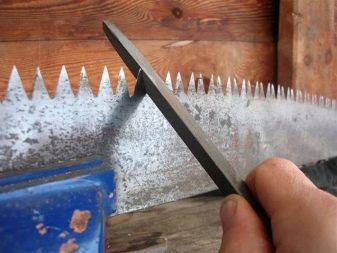
A circular saw will require a pair of wooden blocks, self-tapping screws, a marker, a screwdriver, a jigsaw or a hacksaw, and a ruler.
An industrially manufactured machine is used if the process is more complicated, for example, when sharpening chain, frame cutting surfaces or if there are several saws. A grindstone is used as a working tool.
Chainsaw attachments are used together with a special bar, which is used in order to be able to sharpen while rotating. Sharpener, rhombic stone, circle, disc - these are the forms and types of sharpening tools.


Machine tools, in turn, are divided into electrical and mechanical, the latter are driven only by muscle power. The most sophisticated and expensive electrically driven options allow the operation to be carried out automatically, transforming the grinder into a regular machine operator.
How to sharpen correctly?
The tool sharpening process is quite simple. The blade is clamped in a vice and the teeth are sharpened alternately. First, this is done on one side, and then, turning the canvas over, the manipulations are repeated. Movements should be extremely accurate and monotonous.
Sharpen the saw from the inside towards the set... Naturally, in this case, it is necessary to observe precautions by wearing special gloves. It is recommended to evaluate the result using the "control sawing". The difference "before and after" should be significant: the resulting cut is smoother, much less effort is made.

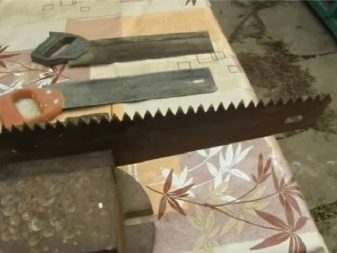
Each saw tooth can be viewed as a small knife, and in the case of a chain saw, as a small plane that enters the material at different angles depending on the technological purpose of the tool.
Teeth can be straight and oblique, trapezoidal or conical. Oblique - the most common, conical, as a rule, perform auxiliary functions, in particular, they are used for cutting laminate.


In any case, the result should be the same: the hand tool at each point moves with equal efforts the same number of times. Burrs are removed with a very fine cut file. For suburban construction or major repairs at home, you can use compact machines.
Before sharpening round discs that are used for work on aerated concrete, you need to clearly understand what kind of alloy we are talking about. Not every abrasive material will cope well with the task: the harder the metal, the more difficult it is to sharpen it..
The wear of the stone and the cleanliness of the processing depend on the correspondence of the abrasive material to the metal, including the grain size. When using machine tools, the speed of rotation also affects the efficiency of sharpening.
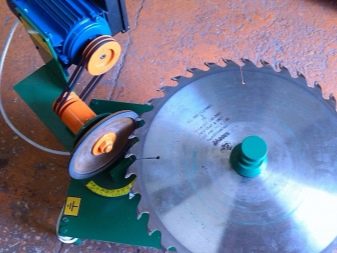
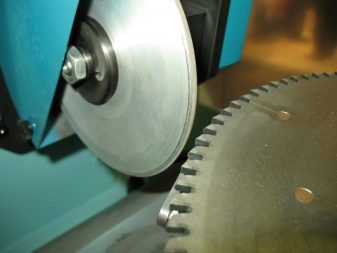
The cutting tool can be tipped and carbide tipped. In this case, experts recommend using abrasive wheels with diamond chips or products made of CBN and silicon carbide. Circular saws sharpen from the side of the rear working surface that is in contact with the material.
Electric saw
An electric or gasoline chain saw uses the chain as a contact cutting surface. It is sharpened in workshops using industrial equipment or do it yourself using a template... In the latter case, round (cylindrical) files with a small diameter are used, which are selected depending on the marking of the sharpened product.
In particular, the Stihl MS brand chain from 180 to 250 will require a file with a diameter of 4 millimeters, for MS 290 and further up to 440, a tool with a diameter of 5.2 millimeters is needed.

The round file only moves forward and nothing else. Direction perpendicular to the chain plane. In addition, when sharpening the chains, a flat file and a template are also used, after installing the template on the tooth, the cutting surface is sharpened.
Before starting work, the tire is clamped in a vice. However, the use of the machine in such a case is still preferable, although there are opposite opinions. If the wear is small, the matter can be corrected in manual mode, but one should not forget about the geometry of the cutting part.
With heavy wear, machine tools are necessary. Sophisticated equipment has a tuning system that allows it to work automatically.

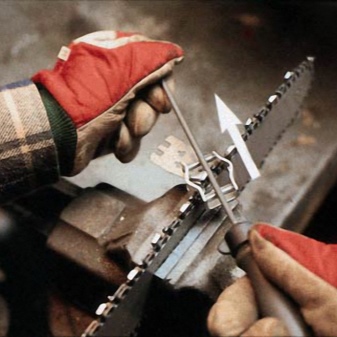
It must be borne in mind that different chains differ in the shape of the teeth, so the tool used must correspond to this.
As a general rule, the teeth are first sharpened in one direction through one, after which the saw turns in the opposite direction and the operation is repeated.
For manual sharpening of chain saws, the tool is sold in sets. Choosing it, you need to understand well which chains will have to sharpen. If, in the course of solving a problem, you have to choose between engine power and chain sharpness, the latter should be preferred.
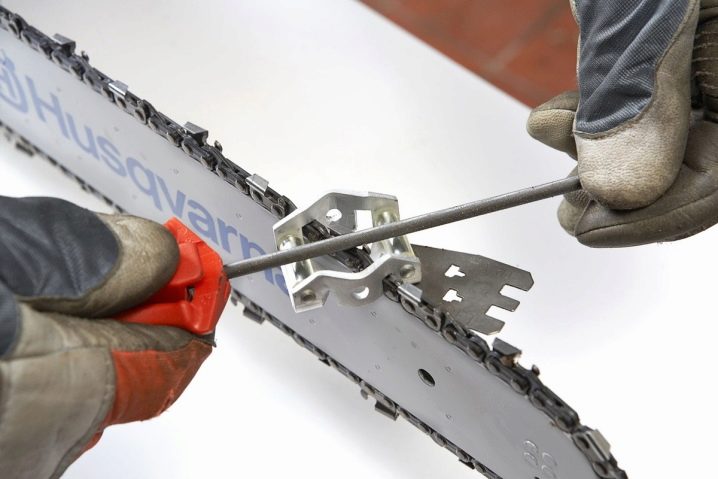
By wood
Any wood saw works very efficiently if it is regularly checked and sharpened. A manual model can be sharpened by hand.
By the way, this way you can sharpen not only a hacksaw or a chain saw, but also a circular saw, which has found wide application in woodwork.
The machine is a good solution, but if only a manual version is possible, the procedure will look like this. First you need to fix the product on a stand that will rotate. Mark the corners with a marker. The template can be a standard disc, taken "on the side" or previously purchased in pairs. If there is none, you will have to take care of your own hardboard template in advance.

Framed
The gang saw is a tool commonly used in sawmills. It serves for longitudinal cutting of wood into boards and beams. Its peculiarity is that the saws are rigidly connected in the form of a frame.
The undoubted advantage of the design is its high performance. When sharpening, it is necessary to take into account the parameters of the teeth, which are usually selected for interaction with a specific material.
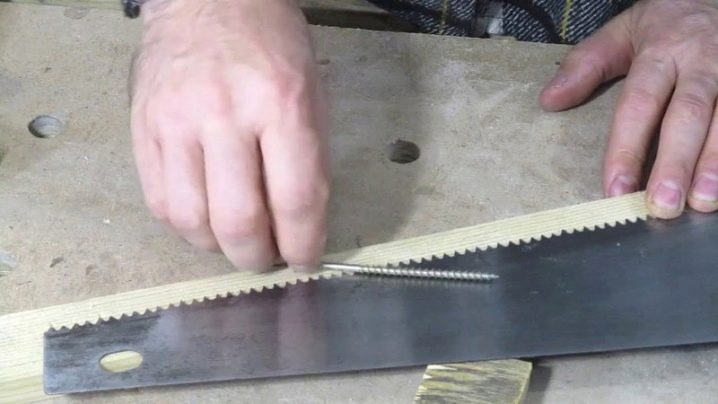
Sharpening gang saws is considered to be more difficult than conventional similar tools for wood.
Extra strong material must be used. The automatic machine copes well with the task at hand, the grinding wheel moves at a certain interval. It is important to maintain the correct angle and avoid mechanical damage.

The width of the set of teeth for sawing fresh coniferous wood should not exceed 0.8 millimeters, the same figures for oak or beech - 0.6 millimeters. The operation is carried out in an industrial way, the grinding material is corundum.
At the end of the work, grinding is carried out. Sharpening gang saws is more difficult because the thickness of the material to be ground is not the same for different teeth. Both the front and back of the teeth are ground.

Helpful hints
- The part to be sharpened, as a rule, is always rigidly fixed; the place of work must be well lit.
- The parts to be processed must be the same in height and shape, which can be checked at the end of the work by placing the product on a sheet of white paper. If the result is not achieved, additional reworking using a file is required.
- The more often the saw is sharpened, the longer it will last.
- An important aspect when carrying out work is compliance with safety measures, full concentration of attention and the absence of distractions are required.
Parts are only handled when the machine is off, otherwise the user risks serious injury.
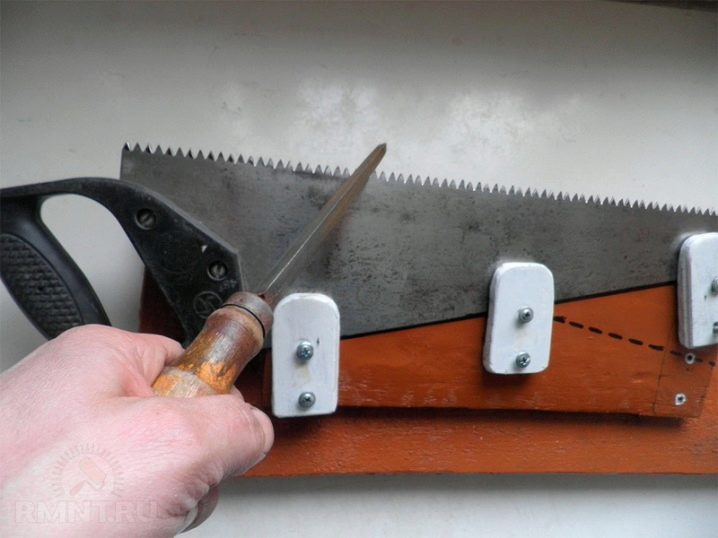
- Sometimes the fine-tuning of a sharpened tool is done with fine sandpaper.
- The teeth should always be brought into the same form, even if only a few are dull. Lack of omissions and strict adherence to technology is the key to success.
- In the event that the saw is not sharpened independently, this operation should be entrusted to a “narrow specialist”, and not to a “general-purpose grinder”. If sharpening is done independently, it should be noted that the use of a vice will greatly facilitate the solution of the problem.
- The quality and quantity of sharpening for a product depends on a number of factors. It is necessary to take into account the hardness of the alloy, the future working material and its volume.


- Naturally, one should also take into account the time elapsed after a similar operation.
- You cannot demand the impossible from circular or chain saws, they are used only as much as declared by the manufacturer, it will be more expensive to deceive yourself.
- Removal of the metal layer depends on the degree of wear. The more you remove, the less the resource will be.
- Handicraft work always differs in its effectiveness from the results of the efforts of a specialist using a machine.

Thus, we will highlight a number of general rules that should not be forgotten when sharpening saws.
- Satisfactory fixation is required. It is provided with the help of devices, including those made by hand.
- Illuminated work area and no distractions.
- A quality tool.
- Monotony, smoothness and observance of the rules of grinding.
- Deburring with a file or a file with a very fine cut.
- Checking the lack of gloss on the cutting edge and the correct geometry of the tooth. If it remains rounded, we can assume that nothing has worked out.
- "Control" cut will show everything. The changes must be substantial.

For information on how to sharpen the saw correctly, see the next video.













The comment was sent successfully.